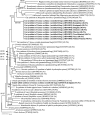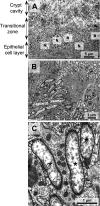Primary gut symbiont and secondary, Sodalis-allied symbiont of the Scutellerid stinkbug Cantao ocellatus
- PMID: 20400564
- PMCID: PMC2876435
- DOI: 10.1128/AEM.00421-10
Primary gut symbiont and secondary, Sodalis-allied symbiont of the Scutellerid stinkbug Cantao ocellatus
Abstract
Symbiotic associations with midgut bacteria have been commonly found in diverse phytophagous heteropteran groups, where microbiological characterization of the symbiotic bacteria has been restricted to the stinkbug families Acanthosomatidae, Plataspidae, Pentatomidae, Alydidae, and Pyrrhocoridae. Here we investigated the midgut bacterial symbiont of Cantao ocellatus, a stinkbug of the family Scutelleridae. A specific gammaproteobacterium was consistently identified from the insects of different geographic origins. The bacterium was detected in all 116 insects collected from 9 natural host populations. Phylogenetic analyses revealed that the bacterium constitutes a distinct lineage in the Gammaproteobacteria, not closely related to gut symbionts of other stinkbugs. Diagnostic PCR and in situ hybridization demonstrated that the bacterium is extracellularly located in the midgut 4th section with crypts. Electron microscopy of the crypts revealed a peculiar histological configuration at the host-symbiont interface. Egg sterilization experiments confirmed that the bacterium is vertically transmitted to stinkbug nymphs via egg surface contamination. In addition to the gut symbiont, some individuals of C. ocellatus harbored another bacterial symbiont in their gonads, which was closely related to Sodalis glossinidius, the secondary endosymbiont of tsetse flies. Biological aspects of the primary gut symbiont and the secondary Sodalis-allied symbiont are discussed.
Figures





References
-
- Abe, Y., K. Mishiro, and M. Takanashi. 1995. Symbiont of brown-winged green bug, Plautia stali Scott. Jpn. J. Appl. Entomol. Zool. 39:109-115.
-
- Akman, L., A. Yamashita, H. Watanabe, K. Oshima, T. Shiba, M. Hattori, and S. Aksoy. 2002. Genome sequence of the endocellular obligate symbiont of tsetse flies, Wigglesworthia glosssinidia. Nat. Genet. 32:402-407. - PubMed
-
- Aksoy, S., and V. M. R. Rio. 2005. Interactions among multiple genomes: tsetse, its symbionts and trypanosomes. Insect Biochem. Mol. Biol. 35:691-698. - PubMed
-
- Arisawa, S. 2003. Constituents of the pericarps of Mallotus japonicus (Euphorbiaceae). Yakugaku Zasshi 123:217-224. (In Japanese with English abstract.) - PubMed
-
- Bourtzis, K., and T. A. Miller. 2003. Insect symbiosis. CRC Press, Boca Raton, FL.
Publication types
MeSH terms
Substances
Associated data
- Actions
- Actions
- Actions
- Actions
- Actions
- Actions
- Actions
- Actions
- Actions
- Actions
- Actions
- Actions
LinkOut - more resources
Full Text Sources
Molecular Biology Databases

